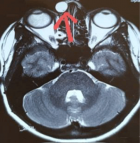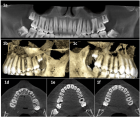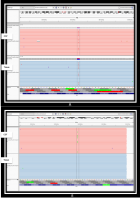Abstract
Research Article
Physiological impact of Zinc nanoparticle on germination of rice (Oryza sativa L) seed
Upadhyaya H*, Roy H, Shome S, Tewari S, Bhattacharya MK and Panda SK
Published: 29 August, 2017 | Volume 1 - Issue 2 | Pages: 062-070
Nanoparticles affects growth and development of Plant. Zinc is an important micronutrient that regulates various physiological responses in plant. Application of nanoparticles for modulating plants physiological response is a recent practice. Zinc nanoparticles has been widely used in industry for several decades. However, no significant work had been made on its potential use in agriculture. Understanding physiological effect of Zn NP on rice seed germination could suggest the basis for its prospective application in agriculture to improve plant growth. In the present experiment effect of Zn NP was studied in Kmj-6-1-1 which is a commonly growing rice cultivar of Karimganj district of Assam, India. An exposure to Zn NP (0 mg/L, 5mg/L,10mg/L, 15mg/L, 20mg/L & 50mg/L) caused significant changes in radicle and plumule length , mass ( fresh & dry mass) and seed moisture content in rice. Antioxidant enzymes like guaiacol peroxidase (GPx), catalase (CAT), superoxide dismutase (SOD) and gluthathione reductase (GR) also increased due to ZnNP treatment. This suggest that Zn NP may significantly alters antioxidant metabolism during rice seed germination. In conclusion, Zn NP protected rice plants from ROS damage by improving levels of antioxidant enzyme activities during germination. As a consequence the Zn NP treated seeds, showed better potential for germination. Further, genomic analysis of germinating rice seeds are needed to elucidate the molecular mechanisms by which Zn NP modulates germination process in rice.
Read Full Article HTML DOI: 10.29328/journal.jpsp.1001008 Cite this Article Read Full Article PDF
Keywords:
Zinc Nanoparticles (Zn NP); Germination; Oryza sativa
References
- Boonyanitipong P, Kositsup B, Kumar P, Baruah S, Dutta J. Toxicity of ZnO and TiO2 Nanoparticles on Germinating Rice Seed Oryza sativa L. Int J Biosci Biochem Bioinfo. 2011; 1: 282.
- Mahajan P, Dhoke SK, Khanna AS. Effect of Nano-ZnO Particle Suspension on Growth of Mung (Vigna radiata) and Gram (Cicer arietinum) Seedlings Using Plant Agar Method.J Nanotech. 2011; 1. Ref.: https://goo.gl/UDCqD5
- Prasad TNVKV, Sudhakar P, Sreenivasulu Y, Latha P, Munaswamy V, et al. Effect of nanoscale zinc oxide particles on the germination, growth and yield of peanut. J Plant Nutr. 2012; 35: 905-927. Ref.: https://goo.gl/RvxzfS
- Mukherjee A, Peralta-Videa JR, Bandyopadhyay S, Rico CM, Zhao L, et al. Physiological effects of nanoparticulate ZnO in green peas (Pisum sativum L.) cultivated in soil. Metallomics. 2014; 6: 132-138. Ref.: https://goo.gl/gZW1L9
- Zhang Z, He X, Zhang H, Ma Y, Zhang P, et al. Uptake and distribution of ceria nanoparticles in cucumber plants. Metallomics.2011; 3: 816-822. Ref.: https://goo.gl/vMQnfQ
- Khan HR, Mc Donald GK, Rengel Z. Zinc fertilization and water stress affects plant water relations, stomatal conductance and osmotic adjustment in chickpea (Cicer arientinum L.). Plant Soil. 2004; 267: 271-284. Ref.: https://goo.gl/NsYTwL
- Hafeez B, Khanif YM, Saleem M. Role of Zinc in Plant Nutrition. Am J Expt Agrl.2013; 3: 374-391. Ref.: https://goo.gl/qY8bCT
- Cakmak I. Enrichment of cereal grains with zinc: agronomic or genetic biofortification? Plant Soil. 2008; 302: 1-17. Ref.: https://goo.gl/q9KNHp
- Kaya C, Higgs D, Burton A, Phosphorus acid phosphates enzyme activity in leaves in leaves of tomato cultivars in relation to Zn supply. CommunSoil Science Plant Ana. 2000; 31: 3239-3248. Ref.: https://goo.gl/wDBAEq
- Katyal JC, Sharma BD. DTPA extractable and total Zn, Cu, Mn and Fe in Indian soils. Geoderma. 1991; 49: 165-179. Ref.: https://goo.gl/QmVjTA
- Sharma A, Patni B, Shankhdhar D, Shankhdhar SC. Zinc-an indispensable micronutrient. Physiology and Molecular Biology of Plants. 2013; 19: 11-20. Ref.: https://goo.gl/fiuP85
- Alloway BJ. Zinc in Soils and Crop Nutrition. 2nd Edition, Brussels-Paris IZA and IFA. 2008.
- Swamy BPM, Inabangan-Asilo MA, Amparado A, Manito C, Reinke R. Progress in development of high grain Zinc rice varieties for Asia. International Zn Symposium. 2015; 32-33.Ref.: https://goo.gl/tnjLZs
- Swamy BM, Rahman MA, Inabangan-Asilo MA, Amparado A, Manito C, et al. Advances in breeding for high grain Zinc in Rice. Rice. 2016; 9: 49. Ref.: https://goo.gl/kTKHFp
- Khan HR, McDonald GK, Rengel Z. Zinc fertilization improves water use efficiency, grain yield and seed Zn content in chickpea. Plant Soil. 2003; 249: 389-400. Ref.: https://goo.gl/k1WNBm
- Lin D, Xing B. Phytotoxicity of nanoparticles: inhibition of seed germination and root growth. Envt Poll. 2007; 150: 243-250. Ref.: https://goo.gl/QJZ9cS
- Cakmak I. Possible roles of zinc in protecting plant cells from damage by reactive oxygen species. New Phytol. 2000; 146: 185-205. Ref.: https://goo.gl/gw6bvN
- Takahashi M, Nozoye T, Kitajima B, Fukuda N, Hokura N, et al. In vivo analysis of metal distribution and expression of metal transporters in rice seed during germination process by microarray and X-ray Fluorescence Imaging of Fe, Zn, Mn and Cu. Plant Soil. 2009; 325: 39. Ref.: https://goo.gl/8RhrsH
- Ishimaru Y, Bashir K, Nishizawa NK. Zn Uptake and Translocation in Rice Plants. Plant Soil. 2011; 6: 1591-1593. Ref.: https://goo.gl/SFFZQC
- Bashir K, Ishimaru Y, Nishizawa NK. Iron uptake and loading into rice grains. Rice. 2010; 3: 122-130. Ref.: https://goo.gl/88WrTt
- Ajouri A, Haben A, Becker M. Seed priming enhances germination and seedling growth of barley under conditions of P and Zn deficiency. J Plant Nutrition Soil Sci. 2004; 167: 630-636. Ref.: https://goo.gl/Fa64Sr
- SlatonNA, Wilson-Jr CE, Ntamatungiro S, Norman RJ, Boothe DL. Evaluation of zinc seed treatments for rice. Agron J. 2001; 93: 152-157. Ref.: https://goo.gl/juP7aw
- Masuthi DA, Vyakaranahal BS, Deshpande VK. Influence of pelleting with micronutrients and botanical on growth, seed yield and quality of vegetable cowpea, Karnataka. J Agric Sci. 2009; 22: 898-900. Ref.: https://goo.gl/Q9q2UC
- Singh MV. Efficiency of seed treatment for ameliorating zinc deficiency in crops. In: Zinc Crops. Improving Crop Production and Human Health. 2007; 24-26.
- Kramer PJ. Water relation of plants and soils. Academic Press. 1995; 495. Ref.: https://goo.gl/jdduRy
- Aebi H. Catalase in vitro. Methods Enzymol.1984; 105: 121-126. Ref.: https://goo.gl/6iJ7cE
- Chance B, Maehly AC. Assay of catalase and peroxidases. Methods Enzymol. 1955; 2: 764.
- Giannopolitis CN, Ries SK, Superoxide dismutase I. Occurrence in higher plants. Plant Physiol. 1997; 59: 309-314. Ref.: https://goo.gl/5WQYA8
- Smith IK, Vierheller TL, Thorne CA. Assay of glutathione reductase in crude tissue homogenates using 5,5′-dithiobis(2-nitrobenzoic acid). Anal Biochem. 1988; 175: 408-413. Ref.: https://goo.gl/ULjk6J
- Upadhyaya H, Dutta BK, Panda SK. Zinc modulates drought induced biochemical damages in tea [Camellia sinensis( L) O Kuntze]. J Agric Food Chem. 2013; 61: 6660-6670. Ref.: https://goo.gl/LwkPxK
- Hu H, Sparks D. Zinc deficiency inhibits chlorophyll synthesis and gas exchange in ‘Stuart’ pecan. Hortic Sci. 1991;26: 267-268. Ref.: https://goo.gl/UGLhXj
- Sharma PN, Kumar N, Bisht SS. Effect of zinc deficiency on chlorophyll contents, photosynthesis and water relations of cauliflower plants. Photosynthetic. 1994; 30: 353. Ref.: https://goo.gl/6v1joZ
- Broadley MR, White PJ, Hammond JP, Zelko I, Lux A. Zinc in plants. New Phytol. 2006; 173: 677-702. Ref.: https://goo.gl/5VYYXR
- Das I, Sanyal SK, Ghosh K, Das DK. Arsenic mitigation in soil-plant system through zinc application in West Bengal soils. Bioremediation Journal. 2016; 20: 24-37. Ref.: https://goo.gl/AH1BkH
- Shahid M, Nayak AK, Shukla AK, Tripathi R, Kumar A, et al. Mitigation of Iron Toxicity and Iron, Zinc, and Manganese Nutrition of Wetland Rice Cultivars (Oryza sativa L.) Grown in Iron‐Toxic Soil. CLEAN-Soil. Air, Water. 2014; 42: 1604-1609. Ref.: https://goo.gl/WaqS4f
- Upadhyaya H, Dutta BK, Panda SK. Impact of zinc on dehydration and rehydration responses in tea. Biologia Plantarum. 2017; 61: 1-4. Ref.: https://goo.gl/hfRnG2
- Asada K, Takahashi M. Production and Scavenging of active oxygen in photosynthesis. Photoinhibition. 1987; 227-287. Ref.: https://goo.gl/KML6aD
- Jebara S, Jebara M, Limam F, Aouani ME. Changes in ascorbate peroxidase, catalase, guaiacol peroxidase and superoxide dismutase activities in common bean (Phaseolus vulgaris) nodules under salt stress. J Plant Physiol. 2005;162: 929-936. Ref.: https://goo.gl/QEdn3J
- Moradi F, Ismail AM. Responses of Photosynthesis, Chlorophyll Fluorescence and ROS-scavenging Systems to Salt Stress during Seedling and Reproductive Stages in Rice. Ann Bot. 2007; 99: 1116-1173. Ref.: https://goo.gl/qbLzMj
- Panda SK, Response of green gram seeds under salinity stress. Indian J. Plant Physiol. 2001; 6: 438-440. Ref.: https://goo.gl/cB4ZWw
- Koji Y, Shiro M, Michio K, Mitsutaka T, Hiroshi M. Antioxidant capacity and damages caused by salinity stress in apical and basal regions of rice leaf. Plant Prod Sci. 2009; 12: 319-326. Ref.: https://goo.gl/LWKUVY
Figures:
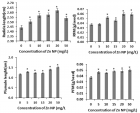
Figure 1
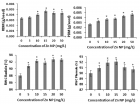
Figure 2
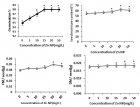
Figure 3

Figure 4
Similar Articles
-
Physiological impact of Zinc nanoparticle on germination of rice (Oryza sativa L) seedUpadhyaya H*,Roy H,Shome S,Tewari S,Bhattacharya MK,Panda SK. Physiological impact of Zinc nanoparticle on germination of rice (Oryza sativa L) seed . . 2017 doi: 10.29328/journal.jpsp.1001008; 1: 062-070
-
Control of rice bakanae disease by seed dressing with mixed solution of fludioxonil, metalaxyl-M and azoxystrobinDeng Chen,Qi-Juan Hu,Xiao-Feng Chen*. Control of rice bakanae disease by seed dressing with mixed solution of fludioxonil, metalaxyl-M and azoxystrobin. . 2023 doi: 10.29328/journal.jpsp.1001096; 7: 001-007
-
The secondary metabolites profiling of the phytopathogenic fungus Sclerotinia SclerotiorumSarah Otun*, Ikechukwu Achilonu, Khayalethu Ntushelo. The secondary metabolites profiling of the phytopathogenic fungus Sclerotinia Sclerotiorum. . 2023 doi: 10.29328/journal.jpsp.1001102; 7: 027-038
-
Agro-morphological Growth Response of Acha (FONIO) (Digitaria exilis and Digitaria iburua [Kippist] Stapf.) Exposed to Colchicine: Germination, Plant Height and Leaf NumberNyam DD*, Gonzuk NS, Sila MD, Tumba YC, Angyu EA, Kwon-Ndung EH. Agro-morphological Growth Response of Acha (FONIO) (Digitaria exilis and Digitaria iburua [Kippist] Stapf.) Exposed to Colchicine: Germination, Plant Height and Leaf Number. . 2024 doi: 10.29328/journal.jpsp.1001133; 8: 055-059
Recently Viewed
-
Sinonasal Myxoma Extending into the Orbit in a 4-Year Old: A Case PresentationJulian A Purrinos*, Ramzi Younis. Sinonasal Myxoma Extending into the Orbit in a 4-Year Old: A Case Presentation. Arch Case Rep. 2024: doi: 10.29328/journal.acr.1001099; 8: 075-077
-
Comparative Study of Cerebral Volumetric Variations in Patients with Schizophrenia with their Unaffected First-degree Relatives, using Magnetic Resonance Imaging Technique, a Case-control StudyMahdiye Fanayi,Mohammad Ali Oghabian*,Hamid Reza Naghavi,Hassan Farrahi. Comparative Study of Cerebral Volumetric Variations in Patients with Schizophrenia with their Unaffected First-degree Relatives, using Magnetic Resonance Imaging Technique, a Case-control Study. J Neurosci Neurol Disord. 2024: doi: 10.29328/journal.jnnd.1001088; 8: 001-007
-
Deciphering the Rosetta Stone - Trans-Mitral Doppler Patterns for a Simplified Study of Left Ventricular Systolic DysfunctionGeorge Thomas*. Deciphering the Rosetta Stone - Trans-Mitral Doppler Patterns for a Simplified Study of Left Ventricular Systolic Dysfunction. Int J Clin Anesth Res. 2023: doi: 10.29328/journal.ijcar.1001023; 7: 008-011
-
Gentian Violet Modulates Cytokines Levels in Mice Spleen toward an Anti-inflammatory ProfileSalam Jbeili, Mohamad Rima, Abdul Rahman Annous, Abdo Ibrahim Berro, Ziad Fajloun, Marc Karam*. Gentian Violet Modulates Cytokines Levels in Mice Spleen toward an Anti-inflammatory Profile. Arch Asthma Allergy Immunol. 2024: doi: 10.29328/journal.aaai.1001034; 8: 001-006
-
Detrimental Effects of Methylenetetrahydrofolate Reductase (MTHFR) Gene Polymorphism on Human Reproductive Health: A ReviewVandana Rai*,Pradeep Kumar. Detrimental Effects of Methylenetetrahydrofolate Reductase (MTHFR) Gene Polymorphism on Human Reproductive Health: A Review. Clin J Obstet Gynecol. 2025: doi: 10.29328/journal.cjog.1001182; 8: 007-014
Most Viewed
-
Evaluation of Biostimulants Based on Recovered Protein Hydrolysates from Animal By-products as Plant Growth EnhancersH Pérez-Aguilar*, M Lacruz-Asaro, F Arán-Ais. Evaluation of Biostimulants Based on Recovered Protein Hydrolysates from Animal By-products as Plant Growth Enhancers. J Plant Sci Phytopathol. 2023 doi: 10.29328/journal.jpsp.1001104; 7: 042-047
-
Sinonasal Myxoma Extending into the Orbit in a 4-Year Old: A Case PresentationJulian A Purrinos*, Ramzi Younis. Sinonasal Myxoma Extending into the Orbit in a 4-Year Old: A Case Presentation. Arch Case Rep. 2024 doi: 10.29328/journal.acr.1001099; 8: 075-077
-
Feasibility study of magnetic sensing for detecting single-neuron action potentialsDenis Tonini,Kai Wu,Renata Saha,Jian-Ping Wang*. Feasibility study of magnetic sensing for detecting single-neuron action potentials. Ann Biomed Sci Eng. 2022 doi: 10.29328/journal.abse.1001018; 6: 019-029
-
Pediatric Dysgerminoma: Unveiling a Rare Ovarian TumorFaten Limaiem*, Khalil Saffar, Ahmed Halouani. Pediatric Dysgerminoma: Unveiling a Rare Ovarian Tumor. Arch Case Rep. 2024 doi: 10.29328/journal.acr.1001087; 8: 010-013
-
Physical activity can change the physiological and psychological circumstances during COVID-19 pandemic: A narrative reviewKhashayar Maroufi*. Physical activity can change the physiological and psychological circumstances during COVID-19 pandemic: A narrative review. J Sports Med Ther. 2021 doi: 10.29328/journal.jsmt.1001051; 6: 001-007

HSPI: We're glad you're here. Please click "create a new Query" if you are a new visitor to our website and need further information from us.
If you are already a member of our network and need to keep track of any developments regarding a question you have already submitted, click "take me to my Query."







